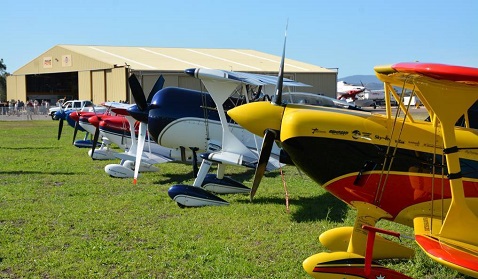The Upper Hunter Shire Council has approved changes to its ambitious plan to put the Scone Regional Airport on a sustainable footing after years of financial losses.
At a special meeting on 7 January, a Council committee supported changes to the construction of the planned terminal, including reducing the building’s overall footprint by 260 square metres. The changes will ensure the $23.5 million project does not go over budget.
Other key elements of the revamp – including a warbird visitor attraction (WVA) centre – remain unchanged.
Extensive airside improvement works are due to be finished in March, and work on the terminal and WVA – as well as new hangars and other fixed assets – is expected to be finished within the year.
The result will likely be one of the Hunter Valley’s most modern small airports, with good prospects for increased operational activities and perhaps even the resumption of Regular Public Transport (RPT) operations.
Crucially, the WVA (and plans for biennial “Warbirds over Scone” air shows) are forecast to make the airport financially self-sustaining.
Scone Regional Airport’s backstory is one with which councils that own aerodromes in other parts of Australia would be familiar: a facility regarded as an important community asset but which is under-utilised and operates at a steady loss.
Expensive infrastructure upgrades necessary to ensure compliance with evolving civil aviation safety standards add to those losses.
In 2011, RPT services to Scone ceased, and while the airport continued to host a local aero club and other general aviation operators, runway drainage problems and other issues limited its utility.
Like many other councils, the Upper Hunter Valley Shire might have opted for the status quo – investing where possible (with state or federal government help) to ensure the airport remained a CASA registered aerodrome while continuing to cover operating losses, in this case about $300,00 a year.
It might even have contemplated closure since there are three airports within 120km of Scone, including Maitland and Cessnock. Newcastle, a large regional hub, is only 150km from Scone.
However, the Scone airport also serves the region’s equine, mining and farming industries, and Council regarded its potential closure as unacceptable. Instead, it wanted to upgrade its asset.
In 2015, Council commissioned a long-term airport masterplan exploring options for how the asset might be developed given operational constraints and the perceived need to support the district’s economic activities, including GA-related business.
It chose the option to fix the runway drainage problem, build a full-length parallel taxiway, install new aircraft parking positions and a refuelling facility, expand the public carpark, and build a new terminal and hangars, an aviation museum, new facilities for the SES and Rural Fire Service, and a council shed.
The upgrade was costed at $23.5 million – $13.5 million for the airside component and $10 million for the non-airside component, including the warbird museum.
The NSW Government pledged to support the project with a $13 million investment through two grants, and Council resolved to secure a loan of $10.5 million.
The warbird centre and biennial air show is a key part of the council’s objective to make the airport profitable.
An independent feasibility study conducted in 2017 forecast the museum will initially attract 9600 people a year and the air show about 8000 visitors, adding about $1.6 million to the Upper Hunter LGA’s economy.
Last year, a Council-commissioned independent CAPEX review of the proposed upgrade warned that air shows should not be relied on as a consistent source of profit.
Relying on conservative growth scenarios, the report showed a benefit-cost ratio value for the project of 1.3 – 1.0 is the point at which a project is expected to deliver a positive net present value.
As a result, the council reduced some of the expectations and assumptions utilised in its financial modelling. It also successfully secured an additional $3 million grant from the Federal Government’s Regional Airports Fund which allowed it to reduce its loan exposure to $7.75 million.
The airport’s opening later this year or early next will be a testament to the council’s foresight and hard work – one that might arguably serve as a template for other local governments with underperforming airport assets.



